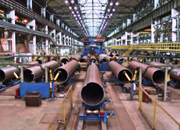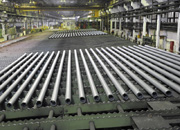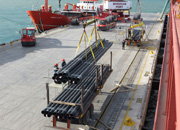First, Chemical Composition and Suitability of
ASME SB407 Nickel-Based Seamless Alloy Steel Pipe.
ASME SB407 nickel-based seamless alloy steel pipe is primarily composed of Ni and Cr solid solutions, containing various alloying elements, and belongs to the NiCr-Pe high-temperature alloy category. Its typical chemical composition includes: Ni content between 30% and 35%, Cr content between 19% and 23%, and certain amounts of Mn, Si, P, S, Cu, Ti, and Al. This alloy design aims to provide excellent mechanical properties and good oxidation and corrosion resistance under high-temperature conditions. In high-temperature environments (600-800℃), ASME SB407 nickel-based seamless alloy steel pipe exhibits considerable thermal strength while maintaining good oxidation and corrosion resistance. This makes ASME SB407 nickel-based seamless alloy steel pipe an ideal material for operation in high-temperature and high-pressure environments, such as in critical fields like petrochemicals, nuclear power, and aerospace.
Second, the physical and mechanical properties of ASME SB407 nickel-based seamless alloy steel pipes.
ASME SB407 nickel-based seamless alloy steel pipes also possess excellent physical properties, with a density of approximately 8.1 g/cm³ and a melting point range of 1357-1385℃. In terms of mechanical properties, this material exhibits high tensile strength and yield strength, not less than 450 MPa and 175 MPa, respectively, while also displaying good elongation (≥30%) and hardness (HB135-179). These characteristics enable ASME SB407 nickel-based seamless alloy steel pipes to maintain structural integrity and stability even under extreme temperature and pressure conditions.
Third, the weldability and process requirements of ASME SB407 nickel-based seamless alloy steel pipes.
Although ASME SB407 nickel-based seamless alloy steel pipes belong to the same austenitic material as austenitic stainless steel, their high Ni content (close to Ni-based metals) significantly improves the plasticity and impact toughness of the nickel-based seamless alloy steel pipes, thereby improving weldability. However, several key issues still need to be considered during welding:
1. Hot cracking susceptibility: In the as-welded state, the weld joint metal microstructure exhibits austenite and a small amount of carbide spots, with a clearly defined cast metal microstructure. The HAZ (Half-Area) grains are coarse, making them prone to solidification cracks caused by intergranular liquid film. To prevent hot cracking, a small welding heat input should be used, and the crater should be filled promptly during operation.
2. Porosity: Compared to pearlitic steel welding, ASME SB407 nickel-based seamless alloy steel pipes have a higher probability of porosity, mainly due to contaminants on the weldment surface. Therefore, thoroughly cleaning the weldment surface is crucial to prevent porosity. If possible, adding 5% hydrogen to the shielding argon gas can increase the reducing power of the shielding gas, which is beneficial for eliminating porosity.
3. Oxidation corrosion: Due to poor thermal conductivity, the weld joint is prone to overheating and oxidation, leading to severe charring defects at the weld root. Simultaneously, chromium depletion at grain boundaries is easily caused at sensitization zone temperatures, affecting the joint's corrosion resistance. Therefore, in addition to welding with low heat input, rigorous argon purging of the pipe is a key process to prevent oxidation and corrosion.
Fourth, Application Areas of ASME SB407 Nickel-Based Seamless Alloy Steel Pipes.
ASME SB407 nickel-based seamless alloy steel pipes, with their excellent high-temperature resistance and corrosion resistance, play an irreplaceable role in many fields:
- Petrochemical Industry: In oil refineries and chemical plants, ASME SB407 nickel-based seamless alloy steel pipes are used to manufacture heaters, heat exchangers, reactors, and piping systems, withstanding the impact of high temperatures, high pressures, and corrosive media.
- Nuclear Power: As a key component in nuclear reactor cooling systems, the reliability and durability of ASME SB407 nickel-based seamless alloy steel pipes are directly related to the safe operation of nuclear power plants.
- Aerospace: In high-temperature, high-pressure, and complex environments, ASME SB407 nickel-based seamless alloy steel pipes are used to manufacture engine components, fuel systems, etc., ensuring the performance and safety of aircraft.
- Marine Engineering: In environments with severe seawater corrosion, ASME SB407 nickel-based seamless alloy steel pipes are used to manufacture subsea pipelines, platform structures, etc., providing long-term stable corrosion resistance.
Fifth, Production Process of ASME SB407 Nickel-Based Seamless Alloy Steel Pipes.
The production process of ASME SB407 nickel-based seamless alloy steel pipes is complex and meticulous, mainly including the following steps:
1. Raw Material Preparation: Selecting alloy raw materials that meet standards to ensure that the chemical composition meets requirements.
2. Smelting: Smelting is carried out using a vacuum induction furnace or electric arc furnace to reduce impurities and gas content, and improve purity.
3. Hot Rolling and Cold Rolling: By precisely controlling temperature and deformation, ideal microstructure and dimensional accuracy are obtained. After hot rolling, solution treatment is required to improve the overall performance of the material.
4. Heat Treatment: Including solution treatment and aging treatment, stress is relieved, and grain structure is optimized.
5. Non-destructive Testing and Surface Treatment: Ultrasonic and X-ray non-destructive testing techniques are used to inspect internal defects in the steel pipes. Simultaneously, surface treatments such as pickling and brightening are performed to improve the appearance quality and corrosion resistance of ASME SB407 nickel-based seamless alloy steel pipes.
Conclusion
ASME SB407 nickel-based seamless alloy steel pipes, with their excellent chemical composition, physical and mechanical properties, good weldability, and wide range of applications, have become a leader in the field of high-temperature alloys. Their superior performance not only meets the high material performance requirements of key fields such as petrochemicals, nuclear power, and aerospace, but also provides strong support for the development of these fields. With the continuous advancement of science and technology and the acceleration of industrialization, the application prospects of ASME SB407 nickel-based seamless alloy steel pipes will be even broader, contributing more to human progress and development.
 Threeway Steel is known as a professional supplier engaged in manufacturing and distributing a wide range of steel pipe, and our headquarter located the central part of China – Hunan and six associated factories throughout China.
Threeway Steel is known as a professional supplier engaged in manufacturing and distributing a wide range of steel pipe, and our headquarter located the central part of China – Hunan and six associated factories throughout China.
 Threeway Steel is known as a professional supplier engaged in designing, manufacturing and distribution of a wide range of steel products with the headquarter located the central part of China – Hunan and six associated factories throughout China.
Threeway Steel is known as a professional supplier engaged in designing, manufacturing and distribution of a wide range of steel products with the headquarter located the central part of China – Hunan and six associated factories throughout China.
 Threeway Steel is known as a professional supplier engaged in designing, manufacturing and distribution of a wide range of steel products with the headquarter located the central part of China – Hunan and six associated factories throughout China.
Threeway Steel is known as a professional supplier engaged in designing, manufacturing and distribution of a wide range of steel products with the headquarter located the central part of China – Hunan and six associated factories throughout China.
 Threeway Steel is known as a professional supplier engaged in designing, manufacturing and distribution of a wide range of steel products with the headquarter located the central part of China – Hunan and six associated factories throughout China.
Threeway Steel is known as a professional supplier engaged in designing, manufacturing and distribution of a wide range of steel products with the headquarter located the central part of China – Hunan and six associated factories throughout China.
 Threeway Steel is known as a professional supplier engaged in designing, manufacturing and distribution of a wide range of steel products with the headquarter located the central part of China – Hunan and six associated factories throughout China.
Threeway Steel is known as a professional supplier engaged in designing, manufacturing and distribution of a wide range of steel products with the headquarter located the central part of China – Hunan and six associated factories throughout China.

